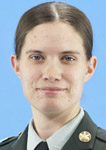The ability to communicate effectively is critically important during disaster-response operations. However, it is even more important for all agencies involved – both military and civilian – to be able to communicate across different frequencies and networks. In the spring of 2012, emergency managers from the Florida Air National Guard’s 125th Fighter Wing received a Mobile Emergency Operations Center (MEOC) equipped with specialized communications platforms that can deploy rapidly and provide much improved communications support during times of sudden disaster. The vehicle is equipped with communication systems that can: (a) support both military and civilian frequency communications; and (b) if necessary, provide the communications links needed between the different systems.
“If we just need to support the Guard, we have the high-frequency radios that will talk to any other military radio,” said Senior Airman Mitchell Snead, an emergency manager with the 125th. Now, “if we need to support civilians, we can also do that.”
The MEOC vehicle made its official debut by supporting the 2012 Statewide Hurricane Exercise, which was held 21-24 May 2012. The exercise provided a welcome opportunity to test not only the vehicle’s operational capabilities but also its ability to link up with other military communication systems (at the Camp Blanding Joint Training Center in Starke, Florida). The exercise confirmed that the vehicle can be an important emergency-disaster asset not only to military units but also, if necessary, to civilian  responders as well. The MEOC is designed “so that any civilian can come in,” Snead commented, “and they can operate out of here as well.”
responders as well. The MEOC is designed “so that any civilian can come in,” Snead commented, “and they can operate out of here as well.”
The Air National Guard is fielding 25-30 similar vehicles throughout the country, officials said, so that a varying number of them will be available at any given time for emergency responses throughout the entire nation. For the Air Force’s own emergency managers, the MEOC vehicle provides an additional tool that will help them perform more effectively in their multi-functional roles – primarily supporting base emergency management and domestic operations, including responses to chemical, biological, radiological, nuclear, and high-yield explosive (CBRNE) situations and incidents. It is, in short, a new and important asset that will help “[us] to better do our jobs,” said Snead. “[Being] an active-duty emergency manager is base-centric, whereas [being in the National Guard] opens us up to all the domestic operations.”

Blair Heusdens
Sgt. 1st Blair Heusdens is a public affairs specialist assigned full-time to the Florida National Guard Public Affairs Office in St. Augustine, Florida, and is a drill status member of the 107th Mobile Public Affairs Detachment. Heusdens enlisted in the U.S. Army Reserve in 2000 as a public affairs specialist. In 2002, she transferred to the Army National Guard and deployed in 2004 to Mosul, Iraq, with the 139th Mobile Public Affairs Detachment. She deployed again in 2009 to Guantanamo Bay with the 107th Mobile Public Affairs Detachment. In 2010, she began work as a full-time Public Affairs Specialist with the Florida National Guard.
-
This author does not have any more posts.






